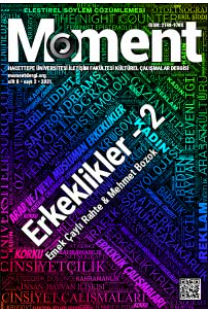SEVİYOR MUSUN BENİ? İDEOLOJİNİN GÜNDELİKLEŞMESİ OLARAK AHSEN TV RÖPORTAJLARI
Bu çalışmada, internet ve Akit TV üzerinden yayın yapan Ahsen TV incelenmiştir. Ahsen TV'nin, Sünni İslam'ın popülerleşme sürecinin anlaşılması için bazı ipuçları sunduğu düşünülmektedir. Kanalda, çoğunluğu sokak röportajı olan videolar yayınlanmaktadır. Bu videolarda röportajı gerçekleştiren tek kişi olan Bülent Yapraklıoğlu, çalışmanın asıl konusudur. Yapraklıoğlu'nun bedeni, giyim-kuşamıyla kendini gösterme şekli ve bu şeklin ifadesi, kanalda yayınlanmış çeşitli videolarda Yapraklıoğlu'nun aldığı çeşitli konumlar üzerinden tartışılacaktır. Röportajlarda sorulara cevap veren kişilerin belirli bir ideoloji tarafından çağrıldığı ve çağrı süresince Yapraklıoğlu'nun ifadesinin, bu ideolojinin gündelikleşmesinde önemli bir etken olduğu ileri sürülmektedir. Böylece Ahsen TV, Yapraklıoğlu'nun bedeni göstergesi ile popülerleşen Sünni İslam'da seyre değer bir izlek sunmaktadır.
DO YOU LOVE ME? INTERVIEWS OF AHSEN TV AS IDEOLOGY BECOMING QUOTIDIAN
In this study Ahsen TV, which is an online video site and participated in Akit TV is examined. It is thought that Ahsen TV reveals some clues on the process of the popularization of Sunni Islam. The videos circulated on the online channel are mostly interviews. The subject matter of this study is the one man executing interviews in these videos, who is Bülent Yapraklıoğlu. The argument will be handled by the positions that are held by Yapraklıoğlu in these videos in respect to his appearance and the enunciation of this appearance. It is claimed that the interviewees are interpellated by a certain ideology, and the enunciation of Yapraklıoğlu casts an important position in the process of this ideology becoming quotidian. So, Yapraklıoğlu with his body signifies a theme worth mentioning in the popularization of Sunni-Islam.
___
- Açıkel, F. (1996). "Kutsal Mazlumluğun 'Psikopatolojisi'". Toplum ve Bilim. #70. s. 153 - 198
- Ahmed, S. (2014). The Cultural Politics of Emotion. Edinburg: Edinburgh University Press
- Aktoprak, E. (2016). "Postkolonyal Bir 'Dava' Olarak 'Yeni Türkiye'nin Yeni Ulusu'". Ankara Üniversitesi SBF Dergisi. #71/1. s. 1-32
- Althusser, L. (1965). For Marx. Londra: New Left Books
- Althusser, L. (1971). Lenin and Philosophy. Londra: New Left Books
- Althusser, L. (2003). "Reading Capital". Semiotics. M. Gottdiener, K. BoklundLagopoulou ve A. Ph. Lagopoulos (ed.) Vol. II. (s. 27-42). Londra, Thousand Oaks, New Delhi: SAGE.
- Durak, Y. (2012) Emeğin Tevekkülü. Konya'da İşci-İşveren İlişkileri ve Dindarlık. İstanbul: İletişim.
- Eagleton, T. (1994) Ideology. Londra, NY: Longman
- Eco, U. (2003) "Towards a Logic of Culture" Semiotics. M. Gottdiener, K. BoklundLagopoulou ve A. Ph. Lagopoulos (ed.) Vol. I (s. 261 - 292). Londra, Thousand Oaks, New Delhi: SAGE.
- Hall, S. (1985). Signification, Representation, Ideology: Althusser and Post-Structuralist Debates. Critical Studies in Mass Communication. No: 2, s. 91-114
- Furedi, F. (2000) Korku Kültürü. Risk Almamanın Nedenleri. (Barış Yıldırım, çev.) İstanbul: Ayrıntı.
- Gregg, M. ve Seigworth, G. (2010) The Affect Theory Reader. Durham-London: Duke University Press.
- Todorov, T. (1984). Mikhail Bakhtin: The Dialogical Principle. (Wlad Godzich, çev.) Minneapolis: University of Minneapolis Press.
- Volosinov, V. N. (1973). Marxism and the Philosophy of Language. NY: Seminar Press
- Volosinov, V. N. (2003). Discourse in Life and Discourse in Art (Concerning Social Politics). Semiotics. M. Gottdiener, K. Boklund-Lagopoulou ve A. Ph. Lagopoulos (ed.) Vol. II. (s. 3 - 26). Londra, Thousand Oaks, New Delhi: SAGE.
- ISSN: 2148-970X
- Yayın Aralığı: Yılda 2 Sayı
- Başlangıç: 2014
- Yayıncı: Hacettepe Üniversitesi İletişim Fakültesi
Sayıdaki Diğer Makaleler
Uluslarötesi Birlikten Ecdada: Türkçe Sözlü İslami Hip-Hop
"İSLAMCI" KİMLİĞİN POPÜLER KÜLTÜREL MÜCADELESİ: EHLİSÜNNET TV SOKAK RÖPORTAJLARI
Halil İbrahim GÜREL, Leyla ŞİMŞEK-RATHKE
İSLAM İLE GÖRSEL MİZAH: TÜRKİYE'DE İSLAMİ MİZAH DERGİCİLİĞİNİN DÖNÜŞÜMÜ
Para Konuşur: Banknotlarda Türk İslam Sentezi
DİNİ YAYINCILIK VE ADNAN OKTAR'IN A9 TV'SİNİN "FANTASTİK" TELE-EVRENİ
POSTMODERN TANRI MİSAFİRİ: POPÜLER "TASAVVUF"ÇULUK
MANEVİ KİŞİSEL GELİŞİMDE ÖZNELLİKLER VE DUYGULANIMSAL BİLGELİK: ALLAH DE ÖTESİNİ BIRAK
1960'LARDAN 28 ŞUBAT'A CEMAATİ ROMANLARLA İCAT ETMEK: SİYASAL İSLAMIN POPÜLER TEZAHÜRLERİ
Çimen Günay ERKOL, Uğur ÇALIŞKAN
Dini Çoğulculuk ve Kamusal Alanda Dindar Tüketim Kültürü
HASAN HÜSEYİN AYGÜL, ÖZGÜR ÖZTÜRK
